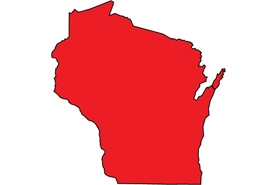Mosquito Fern
(Azolla Pinnata)
The mosquito fern is a free-floating, perennial aquatic fern. The aquatic plant is small, measuring only 3/8 "-1" in diameter. Mosquito fern is generally found in quiet water bodies protected from wind action.
Other names for this plant include:
- Common names: Azolla, feathered water fern, ferny Azolla, water velvet
Classification in Wisconsin: Prohibited
- Ecological Threat
-
- Native plant richness and abundance decrease in the presence of mosquito fern; zooplankton and phytoplankton reduce significantly. As a result, fish production decreases due to the lack of habitat and break in the food chain.
- Although in its native range mosquito fern provides habitat for wildlife and fish, the habitat it provides is one of lesser quality than that it replaces.
- This leads to decreased dissolved oxygen concentration and light penetration, decreased pH levels and nutrient richness and lower water quality.
- Identification
-
Leaves: Mosquito fern is olive green in spring and early summer. By mid-summer and extending into winter, the leaves add anthocyanins, thus causing the leaflets of mosquito ferns to appear red.
Roots: The roots of the mosquito fern hang down into the water approximately 1" from the base of the plant. The roots extract nutrients from the water as the large mats remain free-floating in the water.
Similar species: Mosquito fern can often be mistaken for the similar-looking species duckweed (Lemnoideae spp.)
- Distribution
-
Currently, there have been no reports of mosquito ferns in Wisconsin. Have you seen it? Please send us a report.
- Control
-
Mechanical: Manual removal of the plant is a control option. This can be done by skimming the plant from the surface with fine-mesh nets or a similar device. To yield a higher success rate, a complete collection must be done to limit the number of plants that can reproduce.
Chemical: It has been found that decreasing the amount of phosphorous in the affected waterbody will limit the growth potential of mosquito fern. An abundance of phosphorous, an essential mineral for the growth of mosquito fern, can enter a waterbody in several ways but typically is contributed via run-off from agricultural areas.
Biological: Mosquito fern cannot survive prolonged periods of freezing temperatures, so typically perennial growths of mosquito fern occur in regions protected from protracted freezing.
- Resources
- Sources for content:
- "Texas A&M AgriLife Extension" TAMU AgriLife Extension [exit DNR]
- Global Invasive Species Database Factsheets [exit DNR]
- USDA PLANTS profile [exit DNR]


